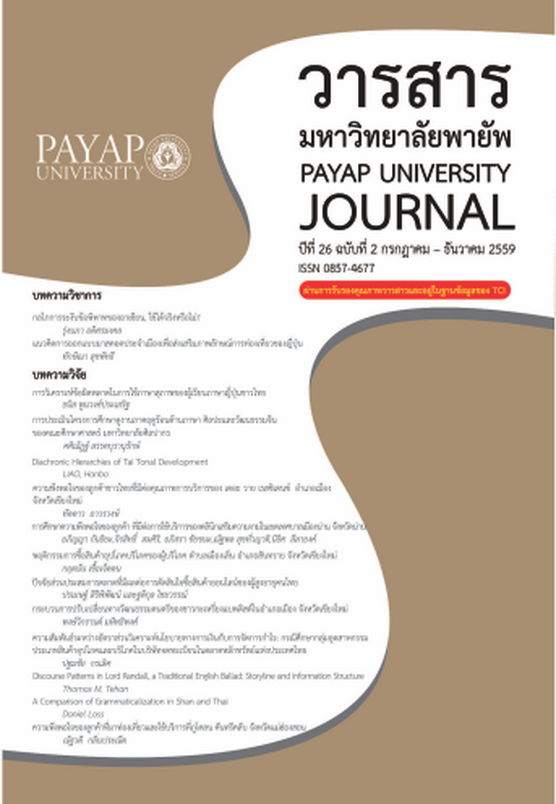ความสัมพันธ์ระหว่างอัตราส่วนวิเคราะห์นโยบายทางการเงินกับการจัดการกำไร: กรณีศึกษากลุ่มอุตสาหกรรมประเภทสินค้าอุปโภคและบริโภคในบริษัทจดทะเบียนในตลาดหลักทรัพย์แห่งประเทศไทย
Main Article Content
Abstract
The purpose of this research is to study the relationship between the leverage ratios and earning management, and also study the relationship between the different leverage levels and earning management with high and low of capital structure. The data from the listed companies in consumption industrial groups in stock exchange of Thailand during period of B.E, 2555-2557, total of105 firm-year was used for analyzing. The statistical methods was used to analyze data in terms of mean, maximize, minimize and standard deviation, and multiple regression analysis. The results showed that only leverage ratio of debt equity ratios had the positive relationship with the earning management. But leverage ratio of debt to total asset ratio, and interest payment ratio had no relationship with earning management. In addition the others financial leverage ratio with different capital structure also no relations between with earning management at the significant level of 0.05
Article Details
References
กฤษณา กัมปนาทโกศล และชาญชัย ตั้งเรือนรัตน์. (2551). “การตกแต่งกำไรกับสัดส่วนการก่อหนี้.” วารสารวิชาชีพบัญชี.4 (10): 66-78.
ตลาดหลักทรัพย์แห่งประเทศไทย. (2558). “โครงสร้างการจัดกลุ่มอุตสาหกรรมและหมวดธุรกิจของตลาดหลักทรัพย์ฯ.” ตลาดหลักทรัพย์แห่งประเทศไทย. 19 กุมภาพันธ์ 2558: 1-4.
ธนิดา จิตร์น้อมรัตน์, เพียรใจ โพธิ์ถาวรและชนิดา เชื้อสุวรรณชัย.(2551). การบัญชีเพื่อการจัดการ: เครื่องมือสำคัญสำหรับผู้บริหารธุรกิจ. พิมพ์ครั้งที่ 3. กรุงเทพฯ: โรงพิมพ์มหาวิทยาลัยธุรกิจบัณฑิตย์: 4-409
นารีรัตน์ เทียมรัตน์. (2556). “ความสัมพันธ์ระหว่างโครงสร้างเงินทุนกับการจัดการกำไร: กรณีศึกษาบริษัทจดทะเบียนในตลาดหลักทรัพย์แห่งประเทศไทย.” บริหารธุรกิจมหาบัณฑิต สาขาบริหารธุรกิจ คณะบริหารธุรกิจ มหาวิทยาลัยเกษตรศาสตร์.
บริษัท 304 อินดัสเตรียล ปาร์ค จำกัด.(2557). “บทวิเคราะห์สำหรับผู้บริหาร” (ออนไลน์) สืบค้นเมื่อ ตุลาคม 2558, จาก:http://www.304industrialpark.com/th/about/executive_review/
ประวัฒน์ เบญญาศรีสวัสดิ์. (2555). “ความน่าเชื่อถือได้ของข้อมูลบัญชี.” Executive Journal.: 39-42.
พิมพ์ชนก ตันต๊ะนา .(2554). “การจัดการกำไรผ่านรายการพึงรับพึงจ่ายของบริษัทที่เสนอขายหุ้นใหม่ แก่สาธารณชนเป็นครั้งแรกในตลาดหลักทรัพย์แห่งประเทศไทย.” บัญชีมหาบัณฑิต สาขาการบัญชี ภาควิชาบัญชี มหาวิทยาลัยเกษตรศาสตร์.
ลิษา สวาทยานนท์. (2551). “Positive Accounting theory และงานวิจัยที่เกี่ยวข้อง.” วารสารวิชาชีพบัญชี. 4 (11): 85-95.
วัฒนี ศิริทัตสวัสดิ์. (2558). “What is Role of Accruals? Do Accounting Models are able to Detect Earnings Management?.” วารสารวิชาชีพบัญชี. 30: 66-77.
สมชาย สุภัทรกุล. (2554). งบการเงิน: ข้อมูลสำหรับการสื่อสารและการตัดสินใจทางธุรกิจ. กรุงเทพฯ: คณะบุคคลอิมเมจิเนียริ่ง:102-145.
สมนึก เอื้อจิระพงษ์พันธ์. (2550). การบัญชีบริหาร. พิมพ์ครั้งที่ 3. กรุงเทพฯ: สำนักพิมพ์เมคกรอ-ฮิล: -584.
สรรพงศ์ ลิมป์ธำรงกุล. (2556). “วิธีวิเคราะห์ว่าบริษัทจะเจ๊งหรือไม่” (ออนไลน์) สืบค้นเมื่อ ตุลาคม, จาก: http://www.investidea.in.th/2013/10/Solvency.html
สถิตย์ ลิ่มพงศ์พันธุ์. (2558). “ปธ.ตลท.ย้ำ Q3 เศรษฐกิจจะดีขึ้น หุ้นหมวดสินค้าอุปโภค-บริโภคยังโต” สืบค้นเมื่อ ตุลาคม 2558, จาก: http://www.manager.co.th/iBizChannel
สำนักงานคณะกรรมการกำกับหลักทรัพย์และตลาดหลักทรัพย์. (2558). “เอกสารเผยแพร่ของบริษัทที่ออกและเสนอขายหลักทรัพย์.”(ออนไลน์). สืบค้นเมื่อ ตุลาคม 2558. จาก http://market.sec.or.th/public/idisc/th/FinancialReport/ALL
สำนักงานคณะกรรมการส่งเสริมการลงทุน. (2556). “อนาคตลงทุนไทย มองอย่างไรในสายตานักลงทุน”. การสัมมนา ณ โรงแรมเจ้าพระยาปาร์ค กรุงเทพฯ. 12 กันยายน 2556: 1-2.
Ardison, M. K.M., Martinez, A. L. & Galdi, F. C. (2008). “The Effect of Leverage on Earning Management in Brazil.” Advances in Scientific and Applied Accounting. Sao Paulo. 5 (3): 305-324.
Brigham E. F. and Houston J.F. (2004). Fundamentals of Financial Management, 10th ed. Thomson: Australia.
Chandra, P. (2011). Financial Management. 8th ed. Tata McGraw Hill Education Private Limited: 76-78.
DeAngelo, L. E. (1986), “Accounting number as market valuation substitutes: a study of manament buyouts of public stockholders”. The Accounting Review. 61(3): 400-420.
Dechow M. P. & Dichev, I. D. (2002). “The Quality of Accruals and Earnings: The Role of Accrual Estimation Errors.” The Accounting Review. 77 (2002): 35-59
Hayes, A. (2015). “Leverage Ratio”. Investopedia, LLC., 1-2.
Hair, J. F., Black, W. C., Babin, B.J., Anderson, R. E. & Tatham, R. L. (2005). “Multivariate data analysis.” 6th ed. Upper Saddle River, NJ: Prentice Hall
Healy, P.M. (1985). “The impact of bonus schemes on the selection of accounting principles.” Journal of Accounting and Economics, 7: 85-107.
Hulster, K. D. (2009). “The Leverage Ratio.” Crisis response. The World Bank. 11: 1-6
Jones, J. (1991). “Earnings management during import relief investigations.” Journal of Accounting Research, 29: 193-228.
Kothari, S.P., Leone, A. J. & Wasley, C. E. (2005). “Performance Matched Discretionary Accrual Measures.” Journal of Accounting & Economics. 39: 163-197.
Mamedova, I. Z. (2009). “The effect of leverage increases on real earning management.” RePub Pubications. Erasmus University: Rotterdam.
Marciukaityte, D. & Szewczyk S. (2011). “Financing Decisions and Discretionary Accruals: Managerial Manipulation or Managerial Overoptimism.” Review of Behavioral Finance, 3: 91-114.
Odabashian, K. (2005). “The Effect of Large Leverage Increases on Opportunistic Behavior and Earning Management.” Degree of Doctor of Philosophy at the University of Connecticut. ProQuest Information and Learning Company.
Sercu, P., Bauwhede, H. V. & Willekens, M. (2006). “Earnings management and Debt.” Faculty of Economic and Applied Economics. Katholieke Universiteit Leuven.
Valipour, H. & Moradbeygi M. (2011). “Corporate Debt financing and Earnings Quality.” Journal of Applied Finance & Banking. International Scientific Press.1(3): 139-157.
Wagman, K. (2013). “The leverage ratio – what is it and do we need it?.” Economic Commentaries. 5: 1-6.
Watt, R. L. and Zimmerman, J. L.(1990). “Positive Accounting Theory: A Ten Year Perspective.” The Accounting Review. 65 (1): 131-156
Zamri, N., Rahman, R. A., & Mohd Isa N. S. (2013). “The Impact of Leverage on Real Earnings Management.” Procedia Economics and Finance. 7(2013): 86-95

